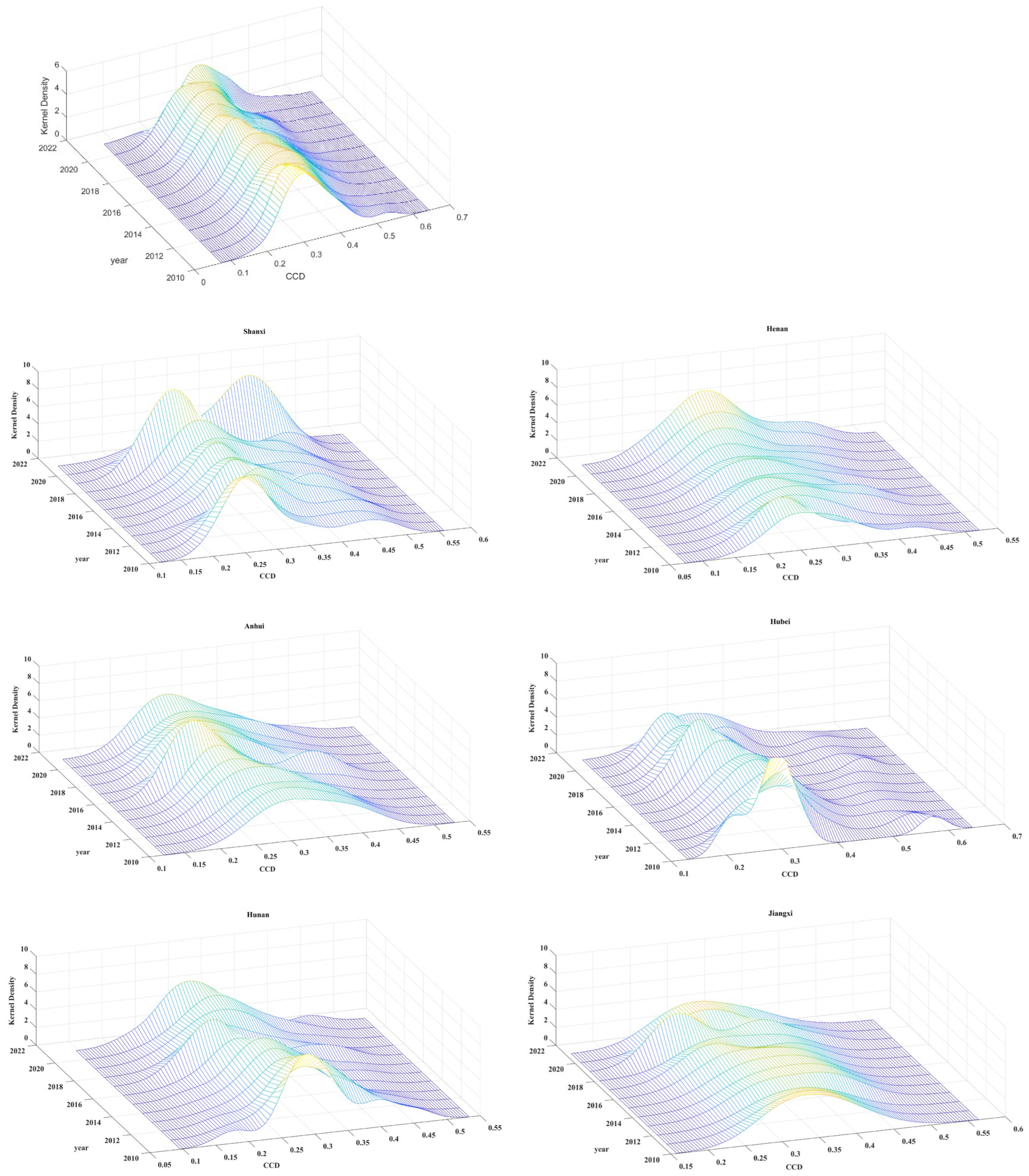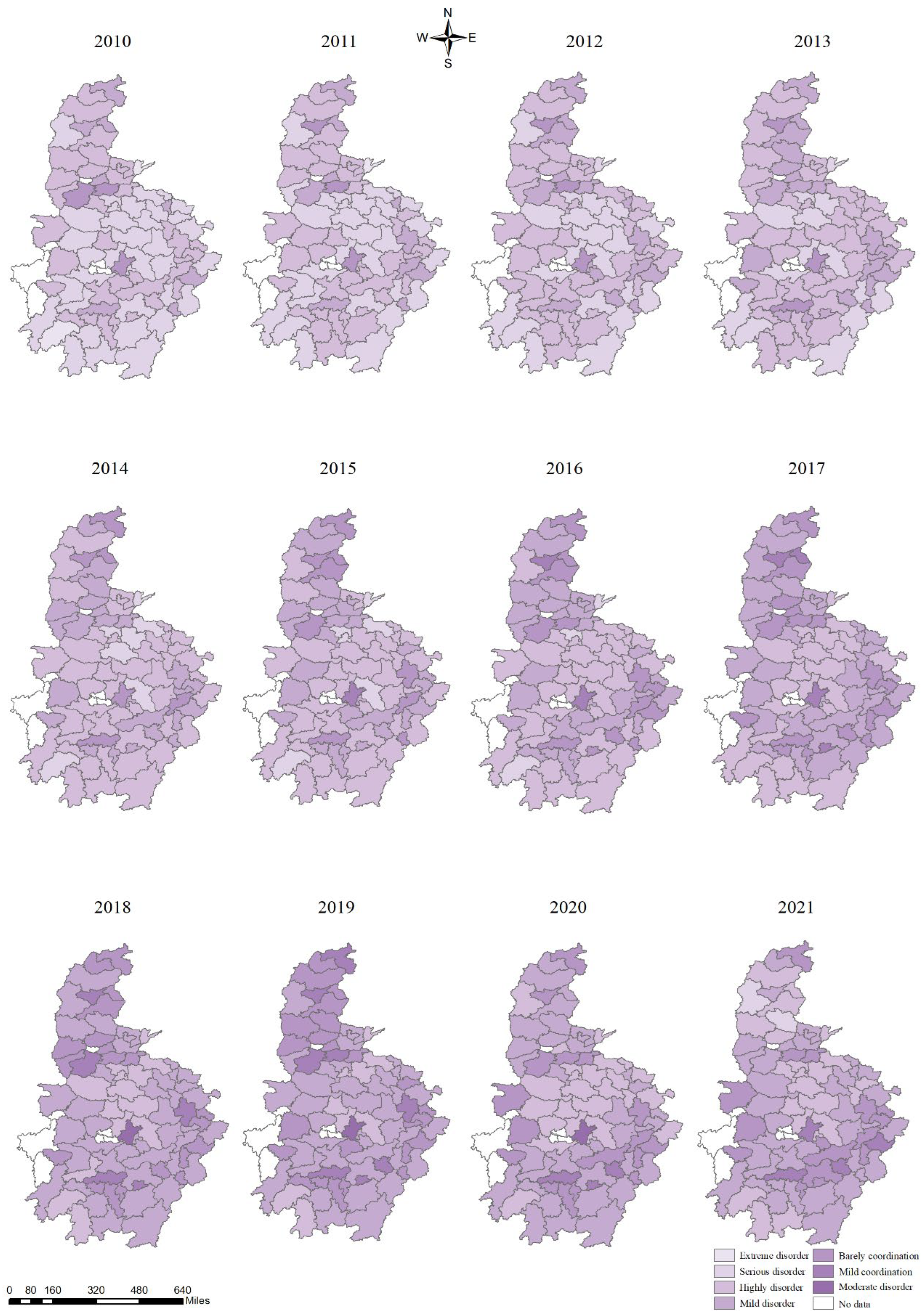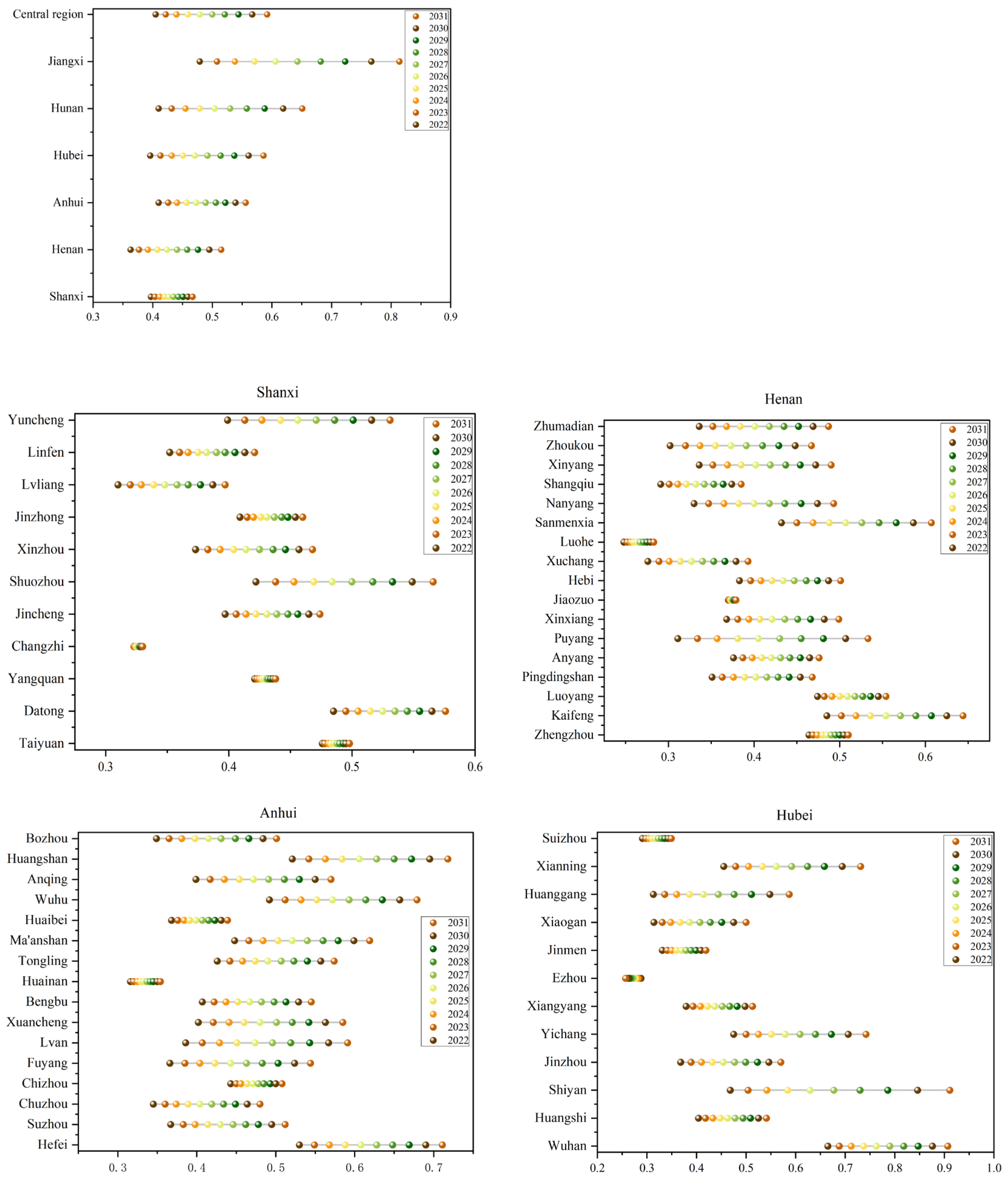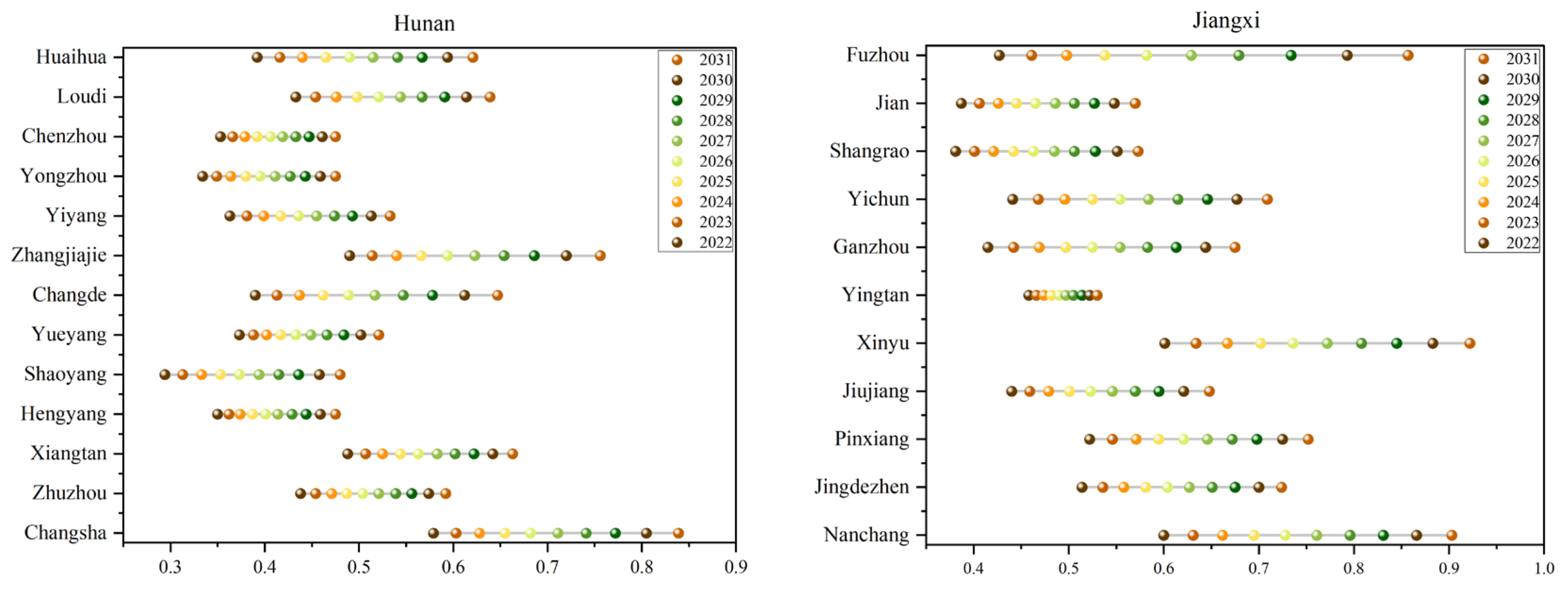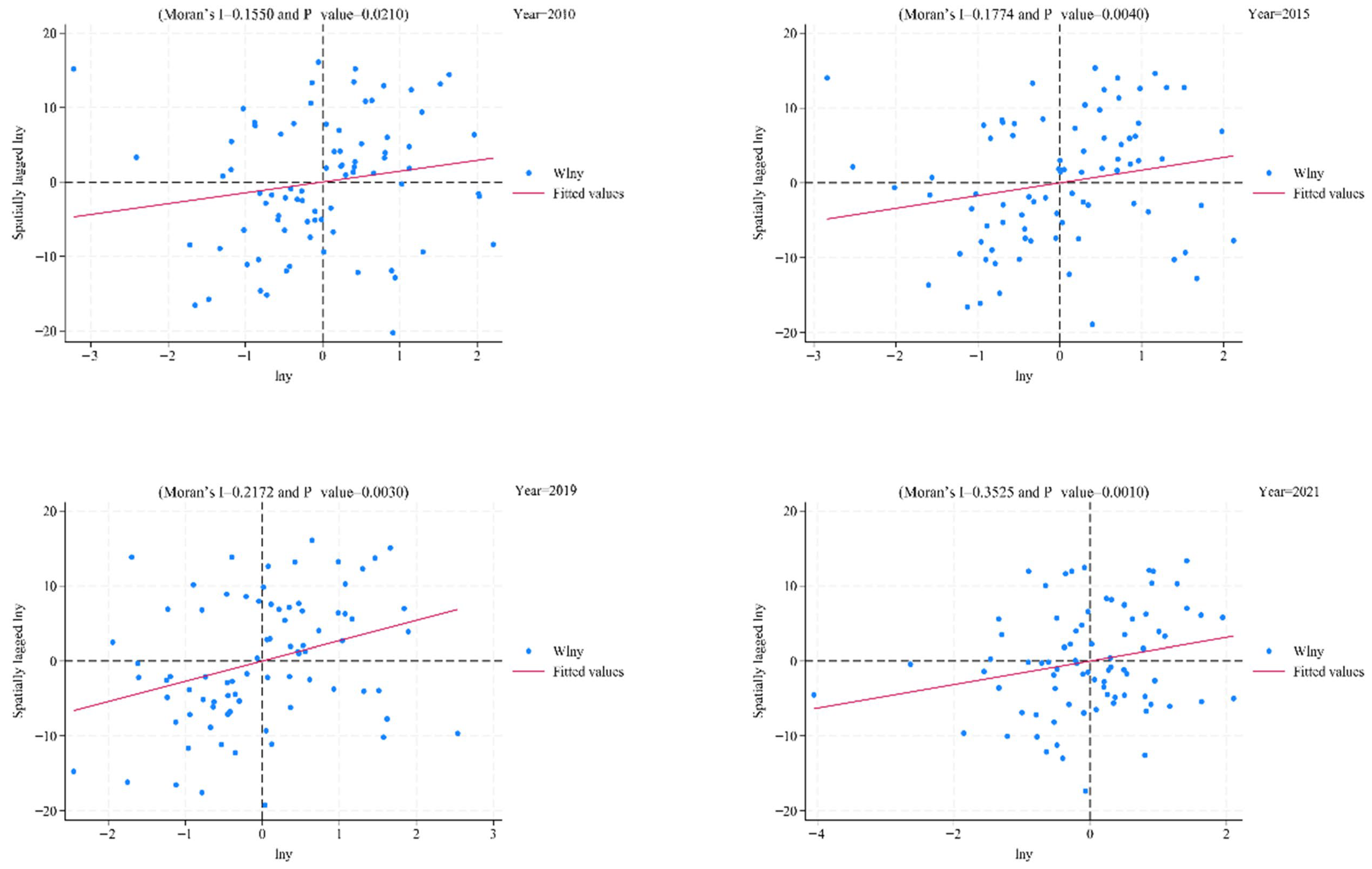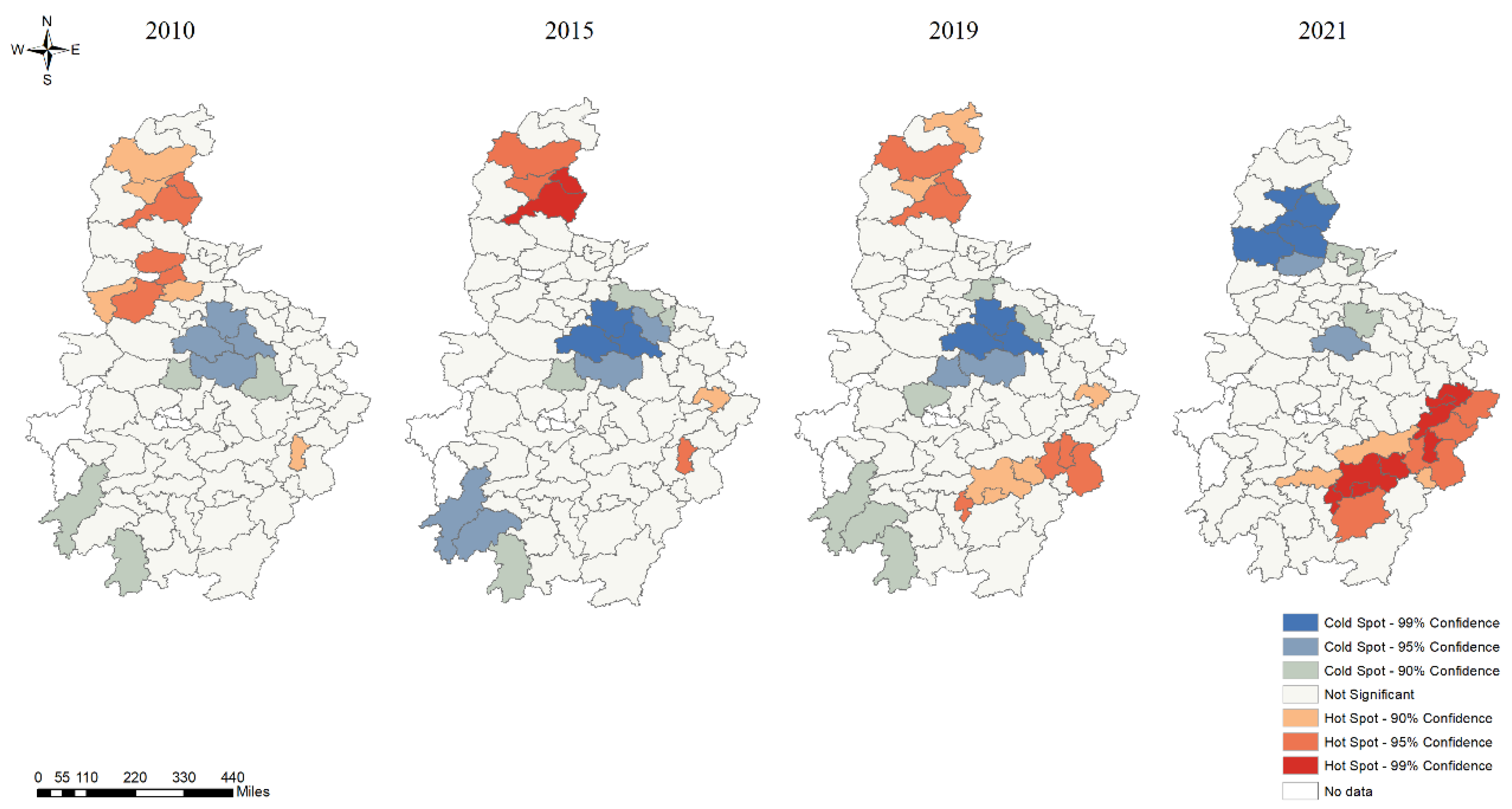1. Introduction
Tourism functions as a powerful driver of sustainable development goals and plays a central role in urban growth globally [
1]. However, the pervasive phenomenon of ‘overtourism,’ evident in heritage cities such as Barcelona and Venice, underscores the urgent need to reconcile tourism expansion with ecological preservation. Developing regions face analogous challenges, where rapid infrastructure development frequently prioritizes economic gains over ecological resilience. This dual dependency highlights that tourism is heavily reliant on the resources and environment of destination cities [
2,
3]. While nations like Costa Rica have strategically leveraged tourism as a conservation tool for rainforests and biodiversity, others, exemplified by Jakarta, experience significant tourism bottlenecks due to chronic traffic congestion, degrading accessibility to cultural sites and forcing itinerary modifications.
Urban planning, functionality, and governance increasingly align with the demands of tourismification—the process through which tourism activities reshape land use patterns, drive economic transitions, and evolve into a dominant lifestyle for residents and visitors [
4,
5,
6,
7]. Driven by the “people’s growing needs for a better life,” this global trend permeates residents’ daily lives and overall urban dynamics [
8]. Manifestations range from residential conversion into guesthouses (e.g., Lijiang) to retail sector shifts towards tourism services (e.g., Paris, Lisbon), often conceptualized as tourism-led gentrification [
9]. While tourismification stimulates digital transformation, urban restructuring, and economic upgrades, it concurrently generates significant negative externalities, including resource depletion, noise pollution, real estate overheating, and broader socio-ecological disruption [
10]. Consequently, it acts as a core factor disrupting economic, social, cultural, and environmental dynamics [
11].
Transportation serves as the essential infrastructure connecting cities and facilitating tourism. A well-developed system promotes regional resource flow, sharing, reduced energy consumption, and industrial optimization and enhances destination appeal and urban aesthetics [
12]. Projects like the China–Pakistan Economic Corridor (CPEC) demonstrate its potential to boost tourism in regions like northern Pakistan [
13,
14]. However, the transportation sector also consumes approximately 10% of national energy and is a primary source of CO
2 emissions, posing significant environmental challenges [
15]. The capacity to develop low-carbon systems varies considerably between economically advanced and less developed regions.
Rapid urbanization has inflicted irreversible damage on urban ecosystems, elevating the importance of ecological resilience—defined as a system’s capacity to absorb disturbances while maintaining essential functions, structure, identity, and feedback mechanisms [
16]. This concept underpins global urban management initiatives like the Rockefeller Foundation’s “100 Resilient Cities” [
17] and is a crucial indicator of overall urban resilience [
18]. Ecological resilience ensures ecosystems maintain balance against short-term fluctuations, preventing overexploitation, preserving carrying capacity, and underpinning ecological civilization [
19,
20,
21,
22]. Sustainable tourism can enhance this resilience [
23], yet urban development, particularly transport expansion, often negatively impacts fragile ecosystems [
24]. Enhancing urban ecological resilience is, therefore, critical for mitigating urbanization challenges and achieving ecological security and sustainable development.
Global urbanization intensifies the interdependence between socioeconomic development, infrastructure demands (especially transport), and environmental sustainability. Tourismification—the systemic transformation of cities into tourism-oriented economies—exerts unprecedented pressure on transport networks and ecological boundaries, challenging urban livability worldwide [
25,
26,
27]. While prior research has examined urban subsystems, including resource–environment–urbanization linkages, economic–resource-energy–environment interactions [
28,
29], and economic–social–environment synergies [
30,
31], the integrated dynamics governing the triad of Urban Tourismification, Transport Efficiency, and Ecological Resilience (UTTES) remain critically underexplored [
32]. This gap impedes the holistic governance of sustainable cities amid escalating climate vulnerabilities and tourism-driven urbanization.
Current understanding is constrained by three key limitations: (1) A deficiency in integrated analysis, where tourismification–transport–ecology interactions are rarely examined as an interconnected triad; (2) temporal oversights in conventional coupling coordination degree (CCD) models, neglecting subsystem developmental disparities and time-lag effects; and (3) methodological constraints in quantifying tourismification’s integration within sustainability frameworks, with spatial drivers of UTTES coordination unaddressed.
To address these critical gaps, this study proposes the Urban Tourismification–Transportation Quality–Ecological Resilience System (UTTES) framework. It hypothesizes that synergistic UTTES development achieves dynamic equilibrium among tourismification’s growth momentum, transport efficiency’s spatial capacity, and ecological resilience’s safety boundaries. Consequently, the research investigates the following questions:
How do tourismification, transport efficiency, and ecological resilience co-evolve spatiotemporally;
Which socioeconomic drivers (economic activity, social restructuring, policy support) govern UTTES coordination;
Does synergistic UTTES development balance tourism growth, transport capacity, and ecological thresholds?
The primary objectives are as follows:
- (1)
Operationalize tourismification metrics within the UTTES framework;
- (2)
Deploy an improved CCD model incorporating a time dynamic coefficient to diagnose spatiotemporal evolution patterns and temporal disequilibrium among subsystems;
- (3)
Identify spatial drivers through advanced econometric analysis.
Theoretically, this study advances complex systems discourse by integrating tourismification into urban resilience paradigms. Methodologically, it innovates through time-sensitive CCD modeling. Empirically, it provides evidence for Tourism–Transport–Ecology governance.
The remainder of this article is structured as follows:
Section 2 synthesizes the conceptual and empirical foundations of UTTES linkages.
Section 3 details the indicator system, the improved CCD methodology, and spatial econometric approaches.
Section 4 presents the spatial–temporal evolution results.
Section 5 discusses the theoretical and policy implications through a comparison of the literature.
Section 6 concludes with governance insights and research limitations.
5. Discussion
This study utilized an improved CCD model incorporating a time dynamic coefficient for the accurate measurement of the UTTES system. To minimize the influence of subjective bias and extreme values on the dataset, combined weights were calculated using the entropy weight method, mean squared deviation weighting, and coefficient of variation method, resulting in more scientifically robust CCD values. Furthermore, to thoroughly analyze historical development trends and future projections of CCD, kernel density estimation and ArcGIS tools were utilized to explore the overall developmental trajectory and spatiotemporal evolution of UTTES coupling coordination. Additionally, the GM (1,1) method was applied to forecast future CCD trends. Finally, a fixed effects model was employed to analyze the driving factors of UTTES. Following spatial autocorrelation validation, the analysis was extended using a spatial Durbin model to examine the spatial spillover effects of these driving factors. The following key insights were identified.
5.1. Core Patterns of the UTTES System
The spatiotemporal evolution of the UTTES (Urban Tourism and Transportation Economic System) composite level reveals three globally relevant core patterns. First, the coexistence of growth resilience and vulnerability to risks parallels the ‘boom-bust’ cycles observed in Caribbean tourism economies during the COVID-19 pandemic. Second, regional differentiation mirrors the gradient disparities between Barcelona’s urban core and Catalonia’s hinterlands, where tourism revenue concentration exacerbates peripheral marginalization. Third, structural contradictions echo the tension between industrial land use and ecological zoning observed in Brazil’s Amazonian cities.
Growth Resilience vs. Risk Vulnerability: The UTTES in central China exhibited an upward trend (4.27% annual growth) but declined sharply post-2019 due to COVID-19. This highlights the fragility of tourism-dependent economies to exogenous shocks [
50], akin to Caribbean Island nations during pandemic lockdowns.
Regional Differentiation: Jiangxi achieved a high growth rate (5.76%), stemming primarily from the digitization of ecological resources, whereas Henan recorded a low average (0.283), reflecting supply-side inefficiencies. Hubei exhibited a pronounced “core-periphery” divide (Wuhan > 0.4 vs. others < 0.4 in UTTES levels), similar to the tourism revenue concentration observed in Barcelona [
48].
Structural Contradictions: Cities like Zhengzhou experienced “valley events” (periods of significant decline), indicating that traditional development models heavily reliant on infrastructure investment face dual pressures from ecological capacity limits and rising market demands. These structural contradictions closely mirror the industrial–ecological conflicts documented in Brazil’s Amazonian cities [
49].
Practical Relevance to Socioeconomic Well-being: Research findings underscore that balanced UTTES development directly enhances human well-being. For instance,
Cities with high CCD (e.g., Wuhan, Changsha) demonstrated stronger recovery in post-pandemic employment and tourism income, thereby supporting progress towards SDG 8 (decent work) and SDG 11 (sustainable cities).
Lagging transportation efficiency (e.g., in Jiangxi) correlated with reduced accessibility to healthcare and education for rural tourists, exacerbating social inequity. This aligns with studies linking transport poverty to multidimensional deprivation in Global South cities [
2].
5.2. Driving Factors and Spatial Spillover Effects
Fixed effects and spatial Durbin models (SDM) were employed in this study to investigate the driving factors of UTTES development and their spatial spillover effects. The results indicate that economic activity levels, social structural transformation, and policy support strength significantly drive the UTTES system. The analysis identified PG, LDF, FC, UL, SSR, TSR, and ER as the key drivers of UTTES coupling coordination. These findings align with the “growth pole” theory, where capital-intensive investments in transportation infrastructure and tourism facilities enhance accessibility and ecological governance through multiplier effects [
52,
53].
However, SSR exhibits a significant negative impact, revealing a critical contradiction: while industrial agglomeration drives economic growth, it simultaneously exacerbates pollution, encroaches on ecological spaces, and impedes tourism experience quality and ecosystem restoration. This observation supports the Environmental Kuznets Curve (EKC) hypothesis, indicating that central China—as a middle-income region—faces a trade-off between industrialization and sustainable tourismification.
The SDM further highlights asymmetric spatial spillovers. Positive spillovers from PG and LDF suggest economically developed cities (e.g., Wuhan, Zhengzhou) act as growth engines, diffusing capital and green technologies to neighboring areas through industrial linkages and policy imitation. Conversely, negative spillovers from UL, FC, SSR, and TSR indicate a “siphoning effect,” where foreign capital and industrial clusters concentrate in core cities, depleting peripheral resources and widening CCD coordination gaps.
Notably, the SSR-UTTES contradiction is not absolute; it can be mitigated through smart manufacturing, industry–city integration, and ecological compensation strategies to foster composite industrial–tourism growth. This spatial polarization reflects “core-periphery” dynamics in regional economics, underscoring the necessity for cross-administrative governance coordination.
5.3. Policy Implications
Based on the historical–spatiotemporal evolution, projected trends, and identified drivers of the UTTES system, this study proposes policy recommendations across three domains.
Institutional–Technological Coordination Mechanism: Post-pandemic governance necessitates a transition from fragmented sectoral management toward a government–industry–academia co-evolution model [
65], with emphasis on institutional coordination, technological empowerment, and spatial restructuring. Specific measures include the following: 1. Establishing cross-provincial tourism risk prevention mechanisms for public health emergencies. 2. Piloting blockchain-based big data regulatory systems in central China. 3. Developing cross-regional cultural corridors and tourism enclave economic zones (e.g., in polarized regions like Hubei), supported by fiscal incentives for core-periphery tourism revenue sharing.
Differentiated Resilience Strategies for Heterogeneous Regions: Building on spatial Durbin model results, tailored pathways are recommended: 1. Industrial-intensive cities (e.g., Zhengzhou): Analysis suggests prioritizing eco-tourism infrastructure and heritage digitization for surplus fund allocation, strengthening cultural preservation and environmental resilience. 2. Tourism-dependent cities: Seasonal adjustment strategies can be achieved through institutional partnerships (e.g., winter wellness tourism collaborations between destination operators and healthcare providers), mitigating demand volatility and optimizing resource allocation. 3. Transportation hubs: Transit-oriented development principles should integrate low-carbon mobility and the “15-min tourism” framework [
66], mandating ≤500 m pedestrian access between 4A-rated attractions and subway hubs with synchronized shuttle services.
Digital-Era Tourism Governance System: A tripartite implementation framework is proposed, comprising the following: (1) A spatiotemporal early warning system utilizing machine learning algorithms (e.g., Baidu migration indices, Ctrip booking data) for predictive CCD threshold monitoring. (2) A policy impact simulator employing multi-agent modeling to assess fiscal intervention efficacy. (3) A stakeholder co-creation model leveraging blockchain technology for participatory tourism budgeting and infrastructure financing. The specific implementation pathways are as follows:
Green Infrastructure Financing: Introduce public–private partnerships (e.g., EU Connecting Europe Facility model) for rail-electrification in lagging cities (Kaifeng, Anqing) to counter SDM-identified “siphoning effects”.
Ecological Compensation: Mandate manufacturing-sector ecological taxes in industrial hubs (e.g., Zhengzhou) to fund urban green corridors (e.g., Wuhan’s “30 km Greenway Initiative”).
Global South Adaptations: Scale UTTES via context-sensitive transport solutions: boat transit networks in archipelagic Southeast Asia (Jakarta) and minibus electrification in African cities (Nairobi) to balance cost-emission goals.
5.4. International Applicability of the UTTES Framework
The UTTES framework offers scalable insights beyond China: Latin America: In Medellín, Colombia, cable-car systems enhanced tourism accessibility within mountainous informal settlements yet compromised ecological resilience through induced soil erosion. The UTTES framework provides a mechanism to quantify and optimize such spatial trade-offs via the proposed CCD model. Southeast Asia: Bangkok’s “overtourism” crisis (transport congestion, temple degradation) mirrors Zhengzhou’s pre-2019 peak. Our GM (1,1) projections provide early-warning thresholds for visitor caps. Africa: Rwanda’s Nyungwe National Park exemplifies “eco-driven” coordination high , akin to Huangshan. However, weak spatial spillovers in our SDM suggest cross-border governance (e.g., East African Community) is critical for scaling success. Limitations in data-scarce regions (e.g., Sub-Saharan Africa) can be mitigated by proxy indicators (e.g., mobile data for tourism flows, satellite imagery for green space).
5.5. Limitations
While this study quantifies the Urban Tourismification–Transportation Quality–Ecological Resilience System (UTTES) via an improved coupling coordination degree (CCD) model and analyzes spatiotemporal trends using kernel density estimation and GM (1,1) forecasting, several limitations persist due to the system’s inherent complexity: Temporal Granularity: The reliance on annual data may obscure short-term fluctuations and shocks within the CCD. Uncertainty and Sensitivity in Weighting: The CCD results are acknowledged to be sensitive to the weighting schemes employed. To address this, a Monte Carlo simulation (1000 iterations) was conducted to test the robustness of the combined weighting approach (entropy method + mean squared deviation + coefficient of variation). The simulation demonstrated that CCD values varied within a range of ±0.03 (95% confidence interval), confirming overall stability. However, sensitivity analysis identified transportation efficiency indicators (X12–X19) as exhibiting the highest volatility (±4.7%). This suggests that for cities characterized by underdeveloped transport infrastructure (e.g., Jiangxi), projections would benefit significantly from higher-resolution data to reduce uncertainty. Future research should incorporate stochastic weighting or Bayesian approaches to better capture the inherent dynamics of the system. Indicator Scope: The current urban tourismification metrics lack behavioral dimensions. Future work should integrate sources like mobile GPS data to refine resident mobility measurements. Spatial Mechanism “Black Box”: The drivers underlying observed spatial spillover effects remain inadequately explored. Integrating qualitative methodologies is recommended to elucidate the governance pathways and causal mechanisms involved.
6. Conclusions
This study employed an improved coupling coordination degree (CCD) model, kernel density estimation, GM (1,1) forecasting, fixed effects regression, and spatial Durbin regression models to analyze the spatiotemporal evolution of the Urban Tourism–Transportation–Ecology System (UTTES) across eighty cities in central China. The analysis identified response thresholds and mechanisms of the UTTES to variations in economic activity levels, social structural transformation, and policy support strength.
The analysis identified major transportation infrastructure development, ecological tourism transitions, and policy coordination as primary determinants of CCD peak value fluctuations. Subsequent driving factor analysis confirmed these relationships. Spatial diagnostics for the terminal observation year revealed relative equilibrium within the ecological resilience subsystem, with disequilibrium predominantly localized in the tourism–economic and transport–logistical subsystems. Spatial distribution analysis revealed a predominance of tourismification-lagging cities, with most simultaneously exhibiting non-lagged transportation development. Eco-driven development patterns characterized Huangshan, Changsha, and Nanchang, contrasting with Wuhan’s distinct transportation-driven growth paradigm. From 2010 to 2019, the UTTES CCD was classified into seven categories: extreme disorder, serious disorder, highly disordered, mild disorder, barely coordinated, mildly coordinated, and moderately coordinated. Post-2014, the number of cities achieving coordinated development increased. The average CCD value rose from 0.220 in 2010 to 0.349 in 2021, peaking prior to the impact of COVID-19. Shanxi Province recorded the highest average CCD value, followed by Jiangxi, Anhui, Hubei, Hunan, and Henan. Notable disparities in CCD values were observed among cities within Hubei Province. Spatially, the CCD distribution exhibited a “periphery-center” hierarchical structure, with high-value regions concentrated in provincial capitals and tourism cities, while low-value regions were found in eastern Hubei and eastern Henan. Future projections suggest the central region will reach the mild coordination phase by 2031, with Jiangxi Province projected to lead by achieving the good coordination phase in that year. Furthermore, the UTTES operates through a dual-path driving mechanism: economic development and financial growth serve as primary positive drivers while manufacturing intensity and stringent environmental regulations present significant obstacles. The core issue involves spatial spillover effects, whereby core cities exacerbate regional differentiation through processes of technological diffusion and resource siphoning.
Theoretical Contribution: This study makes a significant theoretical contribution by proposing the UTTES framework. This framework transcends fragmented approaches focusing solely on sustainable urban development, tourism-driven gentrification, or ecological urbanism. It explicitly integrates and quantifies the complex, dynamic coupling coordination among three critical urban subsystems: tourism, transportation, and ecology. By employing an improved CCD model incorporating temporal dynamics and robust weighting methods (entropy weight, mean squared deviation, coefficient of variation), the framework provides a novel, holistic lens for assessing urban sustainability. It uniquely captures the tensions and synergies between economic growth imperatives (e.g., tourism revenue, infrastructure investment) and ecological constraints, revealing mechanisms such as the dual-path driving (positive finance/growth versus negative manufacturing/environmental intensity) and spatial spillovers (growth engines versus siphoning effects) that shape regional disparities. This addresses a critical gap in understanding the integrated performance and resilience of cities facing pressures like overtourism and climate change.
International Applicability: The UTTES framework demonstrates the considerable potential for international adaptation. Its core methodology, particularly the improved CCD model and the low-data-demand GM (1,1) forecasting technique, offers a scalable tool for cities across the Global South grappling with similar challenges of balancing tourism growth, transport needs, and ecological preservation. As explored in
Section 4.4, the framework provides relevant insights for diverse contexts, such as Medellín (optimizing tourism accessibility versus soil erosion trade-offs), Bangkok (setting visitor cap thresholds using projections to combat overtourism), and Nairobi/Rwanda (implementing context-sensitive transport electrification and evaluating eco-driven coordination). Crucially, the framework can be adapted to data-scarce regions through proxy indicators (e.g., mobile data for tourism flows, satellite imagery for green space). Furthermore, the identified governance challenges, particularly the necessity for cross-administrative coordination highlighted by the spatial spillover effects, resonate strongly with post-industrial cities in advanced economies seeking sustainable transitions and managing regional inequalities.
Practical Implications: The findings yield concrete recommendations for urban planning, sustainable transport, and eco-tourism strategy: Institutional–Technological Coordination: Shift towards government–industry–academia co-evolution models. Establish cross-jurisdictional mechanisms (e.g., tourism risk prevention, blockchain data systems) and develop integrated spatial strategies like cross-regional cultural corridors and tourism enclave economic zones, supported by fiscal incentives for core-periphery revenue sharing. Differentiated Resilience Strategies: Implement tailored approaches: (1) Industrial Hubs (e.g., Zhengzhou): Redirect capital towards eco-tourism and heritage digitization. (2) Tourism-Dependent Cities: Foster seasonal adjustment and wellness tourism partnerships. (3) Transportation Hubs: Integrate low-carbon transport and implement the “15-min tourism city” concept, ensuring scenic spot proximity to transit. Digital-Era Governance: Develop a tripartite system: (1) Spatiotemporal early warning using machine learning (e.g., migration, booking data), (2) Policy impact simulators (multi-agent models), (3) Stakeholder co-creation platforms (e.g., blockchain for participatory budgeting). Green Finance and Compensation: Leverage Public–Private Partnerships (e.g., EU CEF model) for green infrastructure (e.g., rail electrification in lagging cities) and implement ecological taxes in industrial hubs to fund urban green corridors (e.g., greenways). Global South Adaptations: Promote context-sensitive solutions like boat transit networks in archipelagos or minibus electrification in African cities, balancing cost and emissions.
Future studies should integrate climate resilience indicators (e.g., coastal erosion metrics for Small Island Developing States—SIDS) to enhance the framework’s universality. Exploring dynamic feedback mechanisms, such as how eco-tourism revenue can fund transportation upgrades, is also critical. As cities worldwide confront overtourism and the imperative for low-carbon transitions, this study underscores the urgent need to reshape urban development pathways through a lens of fairness and multi-system coordination. The UTTES framework offers a valuable diagnostic and planning tool in this endeavor.




